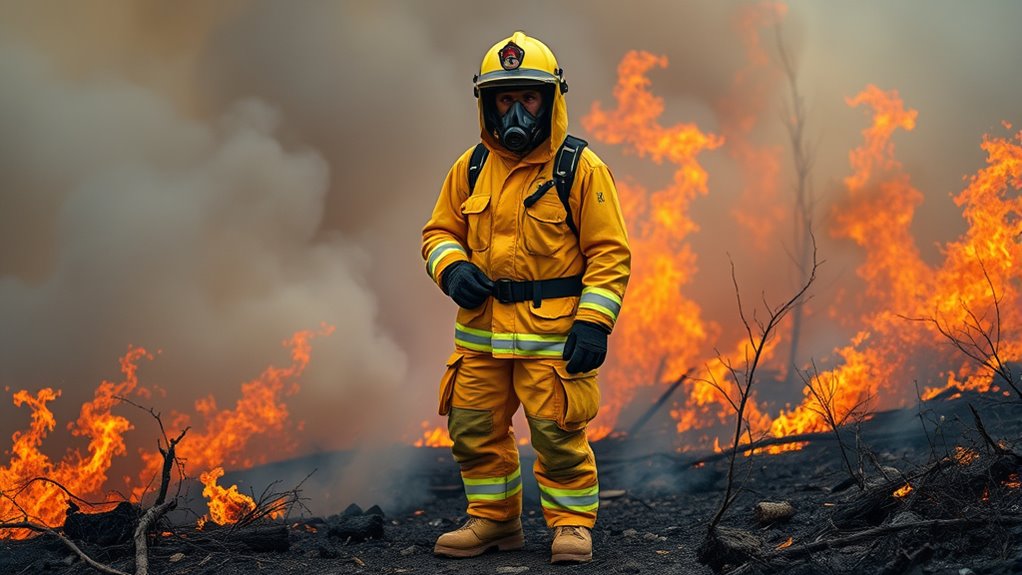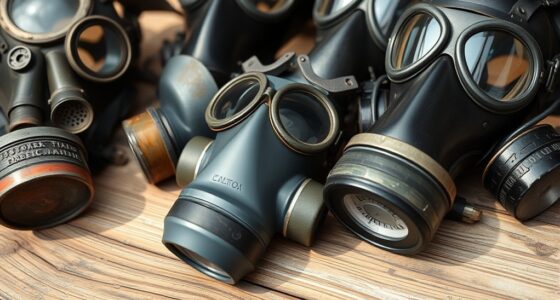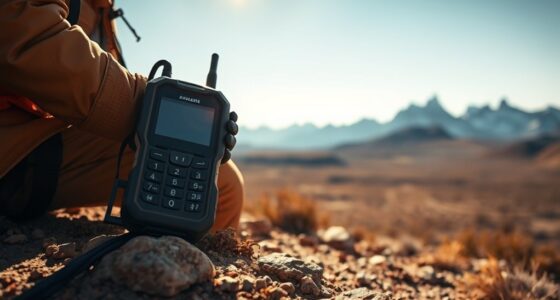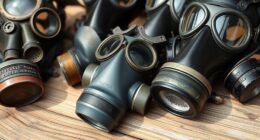To protect yourself from wildfire and smoke, wear fire-resistant clothing made from fabrics like Nomex or Kevlar, covering your entire body to minimize skin exposure. Use respiratory protection such as N95 masks or powered air-purifying respirators to filter harmful particles and gases. Add sturdy gloves, boots, and eye protection like goggles for extensive safety. Proper maintenance and prompt gear replacement guarantee maximum safety. Keep learning about other safety tips to stay better prepared during wildfire emergencies.
Key Takeaways
- Wear fire-resistant clothing made from Nomex or Kevlar to withstand high temperatures and prevent burns.
- Use respiratory protection like N95 masks or PAPRs to filter harmful smoke particles and gases.
- Protect your hands, feet, and eyes with heat-resistant gloves, sturdy boots, and goggles or safety glasses.
- Regularly inspect and maintain all protective gear to ensure optimal safety during wildfire exposure.
- Combine clothing with other safety measures and stay informed about wildfire conditions for comprehensive protection.

When facing wildfires and heavy smoke, wearing the right protective clothing is essential to stay safe. The heat, flames, and toxic smoke pose serious risks, so equipping yourself with proper gear can make all the difference. Fire resistant gear is your first line of defense, designed to withstand high temperatures and prevent burns. Look for clothing made from fire-resistant fabrics like Nomex or Kevlar, which can resist ignition and slow the spread of flames. Cover your body as much as possible, including long sleeves, pants, and a sturdy jacket, to minimize skin exposure. Remember, no clothing is entirely fireproof, so combining fire resistant gear with other safety measures is vital.
Wearing fire-resistant clothing like Nomex or Kevlar is crucial for wildfire safety.
Respiratory protection is equally critical because smoke contains harmful particles and toxic gases that can cause serious health issues. When inhaled, these pollutants can lead to respiratory distress, lung damage, or worse. To avoid this, use a high-quality respirator mask that filters out dangerous particles. N95 masks are a common choice, but for more effective protection, consider masks with P100 filters or powered air-purifying respirators (PAPRs). Ensure your mask fits snugly over your nose and mouth without gaps, so it can do its job efficiently. If you’re working in an environment with dense smoke or toxic fumes, don’t skimp on respiratory protection—your lungs will thank you.
In addition to fire resistant gear and respiratory protection, wearing protective gloves, boots, and goggles can prevent injuries from debris, heat, or flying embers. Fire-resistant gloves guard your hands, while sturdy, heat-resistant boots provide stability and shield your feet from falling or burning objects. Goggles or safety glasses protect your eyes from ash, smoke, and debris, ensuring you maintain clear vision while maneuvering hazardous environments. All these elements work together to create a thorough protective barrier against the dangers of wildfires and smoke.
Ultimately, your safety depends on choosing the right gear and using it correctly. Regularly inspect your clothing and masks for damage or wear, replacing them when necessary. Practice donning your protective gear before emergencies happen so you can do it quickly and efficiently when time is critical. Staying informed about wildfire conditions and following safety guidelines will also help you make smart decisions in dangerous situations. Remember, the goal is to minimize exposure and protect your health and well-being in the face of wildfire hazards. Proper protective clothing, especially fire resistant gear and respiratory protection, isn’t just about compliance—it’s about survival.
Additionally, selecting gear made from fire-resistant fabrics can significantly improve your safety during wildfire events.
Frequently Asked Questions
How Do I Properly Maintain and Clean Wildfire Protective Clothing?
To properly maintain and clean your wildfire protective clothing, always follow the manufacturer’s instructions. Use mild detergent and avoid fabric softeners to preserve fire resistant fabrics. After cleaning, hang the gear to air dry, avoiding direct sunlight. Store your clothing in a proper storage area that’s cool and dry, away from chemicals or heat sources, to guarantee it stays effective and ready for emergency use.
Are There Specific Certifications to Look for in Protective Wildfire Gear?
You should look for wildfire gear certified to standards like NFPA 1977, which guarantee safety compliance and reliable protection. Certifications indicate the gear meets rigorous safety requirements for heat resistance, durability, and fire protection. Always verify the certification labels before purchasing, as this guarantees the gear has been tested and approved for wildfire conditions. Prioritizing certified gear helps you stay safe and compliant during wildfire response.
Can Protective Clothing Be Reused After Exposure to Wildfire Smoke?
Think of your protective clothing as a loyal shield—after smoke exposure, it’s tempting to reuse it, but you shouldn’t. Reusing clothing after wildfire smoke exposure risks lingering particles and contaminants that could harm you later. Always inspect your gear thoroughly, and when in doubt, replace it. Protecting yourself means knowing when your gear has served its purpose and when it’s time for a fresh defense.
What Is the Typical Lifespan of Wildfire Protective Clothing?
You can expect wildfire protective clothing to last around 5 to 10 years, depending on clothing durability and how often you use it. Regular exposure to smoke, heat, and environmental elements can accelerate material degradation, reducing its effectiveness over time. To guarantee safety, inspect your gear frequently for signs of wear, tears, or weakened fabric, and replace it when material degradation compromises its protective capabilities.
How Does Protective Clothing Improve Safety During Wildfire Evacuation?
Imagine slipping into armor that shields you from flames—protective clothing made of fire-resistant materials does just that, improving your safety during wildfire evacuation. It reduces heat transfer and prevents burns. Paired with respiratory protection, it keeps smoke inhalation at bay. This gear acts like a barrier, giving you confidence and safety, even in chaos. Wearing it guarantees you’re better prepared to escape swiftly and avoid life-threatening injuries.
Conclusion
As you gear up with the right protective clothing, you stand resilient against the roaring flames and choking smoke. Picture yourself moving through the smoky haze, the crackling fire fading behind you, your gear shielding you from the intense heat and dangerous particles. With each step, you feel safer, more prepared. Remember, the right clothing isn’t just fabric — it’s your shield, your lifeline, helping you face the wildfire’s fury with confidence and hope.









